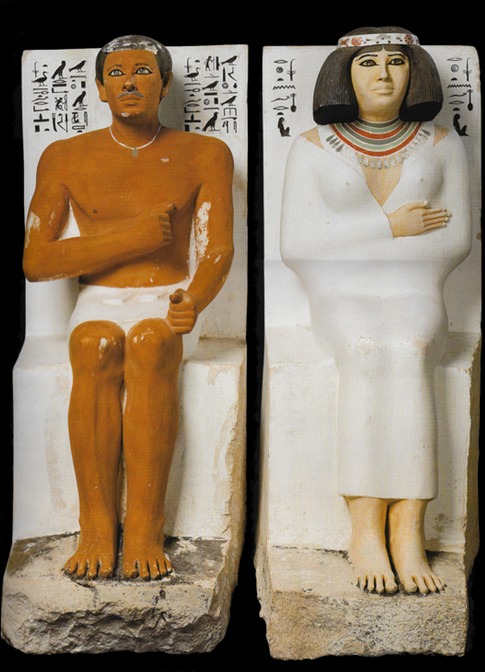Rahotep and Nofret
Title
Rahotep and Nofret
Date
4th Dynasty (Old Kingdom), ca. 2620 BCE
Artist or Workshop
Unknown
Materials
painted limestone
Height of the work
120 cm tall
Provenience
Egypt, Meidum, Mastaba of Rahotep
Current Location
Egyptian Museum at Cairo, Egypt
Sitter Biography
Although the lineages of Rahotep and Nofret are disputed, the discovery of their statues in a brick mastaba in Meidum, confirm the sitters’ high rank. It is believed that Rahotep was was the son of Snofru, the founder of the 4th Dynasty, due to his title as “physical son of the king.” However, some scholars believe that Rahotep’s father was actually Huni, the last king of the 3rd Dynasty. It is also argued that the title, “physical son of the king,” was purely honorific due to Rahotep’s rank as a high official; he served in several offices in the civil administration, in priesthood, and in the military during his life. Rahotep was married to Nofret and her title as “known to the king” indicates her status through her marriage to Rahotep.
Description and Significance
Description:
The under life-size statues of Rahotep and Nofret depict the couple seated in high-backed chairs with footrests. Rahotep is represented with short black hair and a mustache. He wears a short white kilt and an amulet around his neck. His right arm is held across his bare chest, while his left arm is bent by his side with the fist rested on the knee. Nofret wears a dark, shoulder-length wig decorated with a circlet covered in a flower motif. She is enfolded in a long, white gown and wears an elaborate collar around her neck. Her arms are folded across her chest within the garment. Rahotep is painted a reddish-brown color, while Nofret is shown a lighter color. Both portraits contain lifelike inlaid eyes of crystal and their titles are painted, rather than incised, on the backs of their chairs.
Significance:
The portraits of Rahotep and Nofret contain more personal details than most portraits of the Old Kingdom. Rahotep appears to be frowning slightly and he has a mustache, giving the impression that these statues were intended as idealized portraits. The sitters are also portrayed in a youthful manner, furthering the idealized nature. Additionally, the adornments shown on both figures convey a flexibility that could only be present in non-royal portraiture of the time.The skin tones presented are in line with traditional conventions of Egyptian portraiture; the darker color of Rahotep’s skin is meant to signify strength, while the Nofret’s lighter color suggests a feminine delicateness.
The under life-size statues of Rahotep and Nofret depict the couple seated in high-backed chairs with footrests. Rahotep is represented with short black hair and a mustache. He wears a short white kilt and an amulet around his neck. His right arm is held across his bare chest, while his left arm is bent by his side with the fist rested on the knee. Nofret wears a dark, shoulder-length wig decorated with a circlet covered in a flower motif. She is enfolded in a long, white gown and wears an elaborate collar around her neck. Her arms are folded across her chest within the garment. Rahotep is painted a reddish-brown color, while Nofret is shown a lighter color. Both portraits contain lifelike inlaid eyes of crystal and their titles are painted, rather than incised, on the backs of their chairs.
Significance:
The portraits of Rahotep and Nofret contain more personal details than most portraits of the Old Kingdom. Rahotep appears to be frowning slightly and he has a mustache, giving the impression that these statues were intended as idealized portraits. The sitters are also portrayed in a youthful manner, furthering the idealized nature. Additionally, the adornments shown on both figures convey a flexibility that could only be present in non-royal portraiture of the time.The skin tones presented are in line with traditional conventions of Egyptian portraiture; the darker color of Rahotep’s skin is meant to signify strength, while the Nofret’s lighter color suggests a feminine delicateness.
References
www.ancient-egypt.org/who-is-who/r/rahotep-and-nofret.html
www.egyptorigins.org/rahotepandnofret.htm
www.egyptorigins.org/rahotepandnofret.htm
Contributor
Lauren Kershenbaum
Citation
Unknown, “Rahotep and Nofret,” Digital Portrait "Basket" - ARTH488A - "Ancient Mediterranean Portraiture", accessed May 20, 2024, https://classicalchopped2.artinterp.org/omeka/items/show/53.
Item Relations
This item has no relations.

